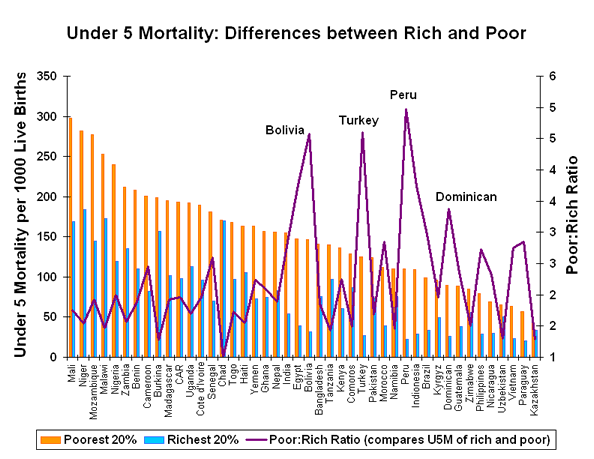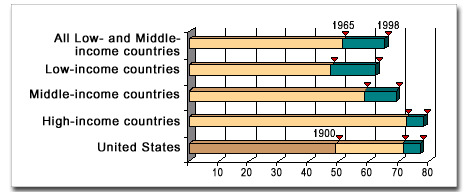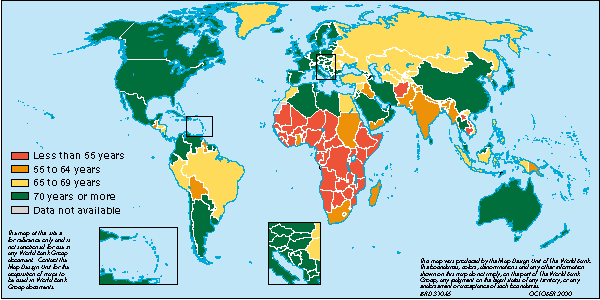|
| |
Causes of Child Deaths
|
Where and why are 10 million children dying every year?
Complete report available from The Lancet The most accurate estimates of the causes of child deaths to date, published
in the March 26, 2005 of THE LANCET, reveal that worldwide more than 70% of
the 10.6 million child deaths that occur annually are attributable to six
causes: pneumonia (19%), diarrhoea (18%), malaria (8%), neonatal sepsis or
pneumonia (10%), preterm delivery (10%), and asphyxia at birth (8%). Robert Black (Johns Hopkins Bloomberg School of Public Health, Baltimore, USA)
and colleagues in an independent group on child health epidemiology, along
with those from the World Health Organisation (WHO), analysed available data
from publications and ongoing studies in 2000 to 2003 to obtain new estimates
for mortality by cause in children younger than age 5 years. They found the
four communicable disease categories account more than half (54%) of all child
deaths. Infection of the blood or pneumonia in newborn babies and pneumonia in
older children constitute 29% of all deaths. Undernutrition is an underlying
cause of 53% of all deaths in children aged younger than 5 years. The
investigators also calculated the total numbers and proportional distributions
of deaths in children younger than age 5 years by cause for the six
WHO-defined regions. Among deaths in children, 42% occur in the WHO Africa
region, and an additional 29% occur in the south-east Asia region. The authors state that the causes of child deaths can be addressed through
existing, available, and affordable interventions. Reducing deaths in the
neonatal period will confront health systems with new challenges, especially
in low-income countries they add. (See The Lancet Neonatal Survival Series,
March 2005) Professor Black comments: "Achievement of the millennium development goals of
reducing child mortality by two-thirds from the 1990 rate will depend on
renewed efforts to prevent and control pneumonia, diarrhoea, and
undernutrition in all WHO regions, and malaria in the Africa region. In all
regions, deaths in the neonatal period, primarily due to preterm delivery,
sepsis or pneumonia, and birth asphyxia should also be addressed. The new
estimates of the causes of child deaths should be used to guide public-health
policies and programmes." In an accompanying commentary Peter Byass (Umeň University, Sweden) states:
"Counting the world's children is not all that is involved in making the
world's children count. It is important to look at the single most important
determinant of childhood death -- which has to be poverty. Childhood mortality
is strongly inversely correlated with per-capita health expenditure. In
today's world, an Ethiopian child is over 30 times more likely than a western
European to die before his or her fifth birthday."
|
Two Key Diarrhoea Facts:
- Of the 10.6 million yearly deaths in children younger than age
5 years: 1.9 million (18%) are caused by diarrhoea.
- Of the 6.6 million deaths among children aged 28 days to five
years: 1.7 million (26%) are caused by diarrhoea. 1 million (61%)
of these deaths are due to the presence of undernutrition.
|
Child deaths: Causes and epidemiological dimensions
Robert E. Black, M.D., M.P.H. - Johns Hopkins Bloomberg School of Public Health
complete Powerpoint presentation available for download from
The Lancet
complete presentation in flash 384 kb click on an image to enlarge
* For the purposes of these charts, one cause has been allocated for each
child death. In practice, children often die of multiple causes and
malnutrition is a contributory cause in approximately one third of all child
deaths. Measles deaths are sometimes ascribed to acute respiratory infection as a severe case of
measles renders a child highly susceptible to other infections and pneumonia is often the
ultimate reason for a death for which measles is primarily responsible.
Infant and Child Mortality
Reducing infant and child mortality is among the eight U.N.
Millennium
Development Goals and one of the agreed upon goals outlined in
A World Fit for Children, the final document of the United Nations
Special Session on Children.
- Infant mortality rate = the number of deaths of infants
under one year of age, in a given period of time, per 1,000 live births in
the same amount of time.
- Children-under-five mortality rate (U5MR) = the probability
of children dying between birth and their fifth birthday, expressed as per
of 1,000 children born alive.
The goal is to reduce by two thirds the mortality rate among children
under five. Global Crisis and Statistics
30,500 children die every day in the lesser-developed world, and half of
these deaths are associated with malnutrition.
- Lesser-developed countries currently have a child mortality rate
of 91*, and the least developed countries have a rate of 161*.
* out of 1,000 live births
- From 1990 to 2000 there has been a 14 percent reduction in the
children-under-5-mortality-rate (U5MR) globally with 3 million fewer deaths.
- More than sixty countries have reached the goal of reducing the U5MR by
one-third (33 percent).
- Unfortunately, U5MR rates increased in 14 countries (nine
of them in sub-Saharan Africa) and were unchanged in eleven others.
Source: The
World Health Organization
Under-Five Mortality Rate
There are wide health inequalities within countries, as well
as between countries. Comparisons made between countries, are comparisons of
the average levels in each country. Within each country, differences between
rich and poor, between men and women, and between dominant and marginalized
ethnic groups, all lead to differences in health and longevity.

UNICEF - Progress for Children:
A Child Survival Report Card: Number 1, 2004

The graph is sorted by child mortality in low income groups,
with the highest child mortality to the left. The mortality rate of the
poorest quintile (20%) of the population in each country is shown in orange,
while that of the richest quintile is shown in blue. The purple, jagged line
indicates the ratio of child mortality for the poor and the rich (poor/rich).
This latter line indicates that some countries, including Bolivia, Turkey, and
Peru, have very large differences between the health of rich and poor
children. This graph suggests that inequality demands particular attention in
Bolivia, Turkey, Peru, the Dominican Republic and several other countries.
From
UC Atlas of Global Inequality
Life Expectancy at Birth, 1965 and 1998

Life expectancy has increased over the past several decades, especially in
low- and middle-income countries. Much of this increase is a result of
improved access to nutritious food, safe water, sanitation, and basic health
care This chart also shows that life expectancy in the United States in 1900
* was 47 years--what it was in low-income countries in 1965. *Source: U.S. Bureau of the Census, Historical Statistics of the United
States: Colonial Times to 1970 (Washington, D.C., 1976).
World Bank
Map. Life Expectancy at Birth, 1990-98

Life expectancy at birth is the average number of years newborn babies can
be expected to live if health conditions stay the same. It reflects the health
of a country's people and the quality of care they receive when they are sick.
Countries with low life expectancy at birth tend to be located in Sub-Saharan
Africa and parts of Asia. Countries with high life expectancy at birth tend to
be located in Europe, North America and parts of Asia and Latin America.
*Source:
World Bank
UNDP charts listing the Life expectancy at birth for all
countries and groups are available:
Male |
Female |
Annual Estimates |
Quinquennial Estimates
updated: 23 April, 2014
|